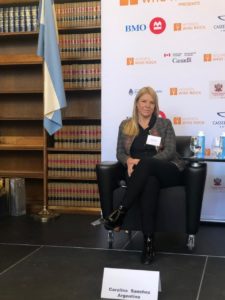Exclusive Interview: Argentina promotes its mineral sector at PDAC

By Ellsworth Dickson

During the recent PDAC Convention in Toronto, Carolina Sanchez, Secretary of Mining Policy,
Ministry of Production and Labor, Argentina, spoke to Resource World about her country’s efforts to grow their mining industry.
RESOURCE WORLD: Vanadium has been attracting attention lately. Is Argentina is prospective for vanadium deposits?
CAROLINA SANCHEZ: Yes. There are orogenic deposits of vanadium at the northwest and in the central Andean region of Argentina.
RW: Sometimes vanadium deposits also contain uranium. Is that a problem or if it is a problem, can that problem be solved?
CS: There are deposits with and without uranium in Argentina. A company called Blue Sky
Uranium Corp. is currently advancing its Amarillo Grande vanadium-uranium property in Rio Negro province. This is a uranium deposit with vanadium credits – in this case of sedimentary origin. This project has a positive PEA with very good potential. Yes, the two metals can be separated. Blue Sky has other uranium projects in Argentina as well.
RW: Could you talk a little bit about lithium? Is Argentina a good place to explore for lithium?
CS: Yes. In the last three years, exploration budgets for lithium have increased by about 900%.
Most of the investments are for brine resources [salars] but there is also hard rock spodumene exploration as well.
RW: I know there are a few Canadian companies in Argentina. Are you trying to attract other countries to invest in mining projects in Argentina as well?
CS: Yes, we are seeing companies from different countries now arriving in Argentina. These include groups from France, Germany, Korea, China, Australia and Canada.
RW: For all those countries to be interested in Argentina, your government must be making efforts to attract them. Do you have some incentives for explorers to come from all over the world to your country?
CS: Yes, we have a Promotion of Mining Investment Law that establishes benefits at different stages. We also have a reimbursement of the VAT [Value Added Taxes] that is very important for a company at the exploration stage. Then we have tax benefits on tariffs for the import of capital goods and some raw materials for the mining sector and a double discount of expenditures in the exploration stage for income taxes. We know exploration companies consider this important.
RW: Does Argentina have services for mineral explorers like diamond drilling companies?
CS: We have many small and medium suppliers of goods and services for mining sector, who can form joint ventures with other mature suppliers. There is machinery already in Argentina that could easily provide these services to mining companies.
Also, we have a great deal of experience in the oil and gas industry. The supply chain of the oil industry, which is very large in Argentina, could easily transform itself into being a supplier to the mining industry.
RW: In countries like Canada and the United States, their governments have a great deal of geological information available. Does your government have websites with lots of geological information that can help explorers?
CS: Yes. Much Argentina geological information has been digitalized and has been put online to be available for free. Anyone can access the information. Information on geological projects, mining and, in addition, all the filings that need to be done, all the procedures, permitting – they are all being digitalized and put online. For the time being, it is in Spanish.
RW: Eventually, will be in English?
CS: Yes. The geological maps are interactive so you can easily understand what you’re looking at that needs less translation. The rest – mining project information, stage of permits, etc – is in the process of being translated. (http://cima.minem.gob.ar/)
We are here at the PDAC Convention to show the potential we have in Argentina – that it is a good country trying to promote good investments. We want to help investors to develop their projects. As a country, and with our provinces, we are improving the competitiveness for mining development, improving our infrastructure and working conditions, and lowering energy costs.
